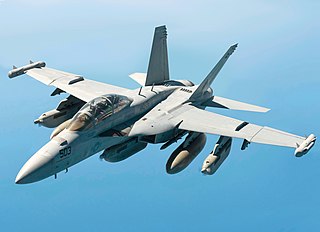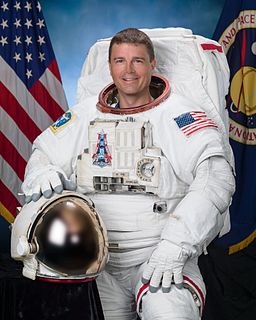
The Boeing EA-18G Growler is an American carrier-based electronic warfare aircraft, a specialized version of the two-seat F/A-18F Super Hornet. The EA-18G replaced the Northrop Grumman EA-6B Prowlers in service with the United States Navy. The Growler's electronic warfare capability is primarily provided by Northrop Grumman. The EA-18G began production in 2007 and entered operational service with the US Navy in late 2009. Australia has also purchased twelve EA-18Gs, which entered service with the Royal Australian Air Force in 2017.

Pacific Missile Test Center (PMTC) is the former name of the current Naval Air Warfare Center, Weapons Division. The name of the center was the Naval Air Missile Test Center prior to PMTC. It is located at Naval Base Ventura County/Naval Air Station Point Mugu in Ventura County, California. The nearest city to the installation is Oxnard.

Naval Air Weapons Station (NAWS) China Lake is a large military installation in California that supports the research, testing and evaluation programs of the United States Navy. It is part of Navy Region Southwest under Commander, Navy Installations Command, and was originally known as Naval Ordnance Test Station (NOTS).

The Vought F6U Pirate was the Vought company's first jet fighter, designed for the United States Navy during the mid-1940s. Although pioneering the use of turbojet power as the first naval fighter with an afterburner and composite material construction, the aircraft proved to be underpowered and was judged unsuitable for combat. None were ever issued to operational squadrons and they were relegated to development, training, and test roles before they were withdrawn from service in 1950.
VX-4, Air Test and Evaluation Squadron Four,, commonly referred to by its nickname, The Evaluators) was a United States Navy air test and evaluation squadron based at Naval Air Station Point Mugu, California. Their tail code was XF, and they flew the McDonnell Douglas F-4 Phantom, Grumman F-14 Tomcat and the McDonnell Douglas F/A-18 Hornet until their disestablishment in 1994.

Air Test and Evaluation Squadron Nine is a United States Navy air test and evaluation squadron based at Naval Air Weapons Station China Lake, California. Using the tail code XE, the squadron operates numerous aircraft and helicopters of the United States Navy and United States Marine Corps.
Air Development Squadron 3 or VX-3 was a United States Navy air test and evaluation squadron established on 20 November 1948 and disestablished on 1 March 1960.

Air Test and Evaluation Squadron 23 (VX-23) is an aviation unit of the United States Navy based at Naval Air Station Patuxent River, Maryland, United States. The squadron was established on 22 July 1995. Using the tail code SD, the squadron operates multiple aircraft types of the United States Navy for test and evaluation purposes.

The Operational Test and Evaluation Force (OPTEVFOR) serves as an independent and objective agency within the United States Navy for the operational testing and evaluation (OT&E) of naval aviation, surface warfare, submarine warfare, C4I, cryptologic, and space systems in support Navy and U.S. Department of Defense acquisition programs.
Naval Air Warfare Centers are research organizations within Naval Air Systems Command. The centers are grouped within the following divisions:

VX-20, Air Test and Evaluation Squadron Twenty, is a United States Navy air test and evaluation squadron based at Naval Air Station Patuxent River, Maryland.

Gregory Reid "Tonto" Wiseman is an American astronaut, engineer, and naval aviator. Wiseman was selected in June 2009 as a member of the NASA Astronaut Group 20 and qualified as an astronaut in 2011. Wiseman took part in his first spaceflight as part of the crew of Expedition 40/41, which launched to the International Space Station on May 28, 2014, and returned on November 10, 2014. Before joining NASA, Wiseman was a Naval Aviator and test pilot. Wiseman was the Deputy Chief of the Astronaut Office from June 2017, working under Chief Astronaut Patrick Forrester. On December 18, 2020, he was promoted to Chief of the Astronaut Office at NASA.

Air Test and Evaluation Squadron 30, nicknamed The Bloodhounds) is a United States Navy air test and evaluation squadron based at Naval Air Station Point Mugu, California. Using the tail code BH, the squadron flies the E-2D Hawkeye, Lockheed P-3 Orion, and the Lockheed C-130 Hercules aircraft. The VX-30 Bloodhounds provide support to the United States Navy's Sea Test Range off the shores of central California.

Air Development Squadron Six was a United States Navy Air Development Squadron based at McMurdo Station, Antarctica. Established at Naval Air Station Patuxent River, Maryland on 17 January 1955, the squadron's mission was to conduct operations in support of Operation Deep Freeze, the operational component of the United States Antarctic Program.

Antarctic Development Squadron Six was a United States Navy air test and evaluation squadron based at Naval Air Station Point Mugu, California with forward operating bases at Christchurch, New Zealand and McMurdo Station, Antarctica.
Cast Glance is a gyrostabilized optical instrument used by the United States Navy and United States Air Force. It is an airborne system that is used by Air Test and Evaluation Squadron 30 (VX-30) on board the Lockheed NP-3D Orion. The system consists of a moving gyro-stabilised mirror with fixed optics, two fixed cameras and five sensors. The cameras look out of the starboard side of the aircraft. The system is photometric and enables the simultaneous recording of the electro-optical to the infrared spectrum and medium wave IR.
VX-1, Air Test and Evaluation Squadron One, is a United States Navy air test and evaluation squadron based at Naval Air Station Patuxent River, Maryland.

The Lockheed Martin F-35 Lightning II is a family of stealth multirole fighters that first entered service with the United States in 2015. The aircraft has been ordered by program partner nations, including the United Kingdom, Italy, Norway, and Australia, and also through the Department of Defense's Foreign Military Sales program, including Japan, South Korea, and Israel. The units that operate or plan on operating the aircraft are listed below.













